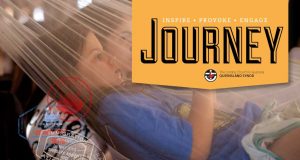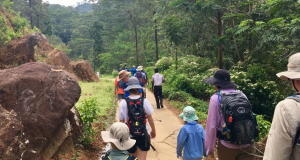Thinking about making a few changes to your church facilities—perhaps updating the kitchen or building a new hall? Dianne Jensen looks at church redevelopment.
Many Queensland congregations faced with ageing infrastructure or changing demographics have made the decision to redevelop their facilities, with some outstanding examples of clever design generating new ministries. Others have chosen to transform existing areas, creating multi-use zones or turning underutilised areas into community spaces.
As any redevelopment team member will attest, bringing projects to a successful conclusion requires stout hearts and a commitment to keeping the vision alive throughout the long process. A good outcome also depends on a shared understanding of the congregation’s mission in the local community.
Uniting Church members Narelle and Craig Mercer have provided architectural and town planning services to many congregations through their consulting firm Mercer & Mercer.
“The mission statement is a crucial part of the process,” says Narelle. “If every congregation understood clearly what they are trying to do in their community and in their own congregation, it would start to inform their decisions about what to do and flow on to the property decisions they make.”
Shared vision
Rev Melissa Lipsett is Executive Minister at Newlife Uniting Church on the Gold Coast, which has just completed a major redevelopment. She says that the mission statement played a vital role in helping the congregation plan the new facility.
“The mission statement provides the vision—so that everyone knows what they are working toward. The Newlife congregation understood that we needed to extend our facilities to provide empty chairs for those who were yet to come. Shared responsibility for this vision meant a shared commitment to sacrificially contribute to that vision.”
Understanding the mission priorities of the congregation enabled the redevelopment team to make choices about what was most important.
“Newlife worked hard to decide what was worth compromising about and what wasn’t. We have a beautiful space in which to worship God, but we also have modern, clean facilities for our children and young families. Community gathering space was an important part of the redevelopment and we are thrilled with the undercover courtyard space and adjacent playground that enables people to come together in all weather. Good technology—including excellent audio and vision technology—is expensive so it’s really important to get it right, but doing so will pay dividends.”
The Lifeworks Glenvale project in Toowoomba has been a long time in the development phase since the initial go-ahead in 2002 to purchase a 10-acre parcel of land. The multi-million dollar project involves selling a number of church properties, with the stage one Outside School Hours Care service and worship facilities due for completion in May 2015. The second stage will feature a dedicated worship space.
Rev Tim Griggs, Lifeworks Uniting Church team leader, says the church mission statement was a key factor in guiding the congregation.
“The genesis of the project was the realisation that while the city was bursting at the western seams, our congregation was sitting virtually in the city centre, close to other Uniting Church congregations. Mixed in with the fact that our current facilities were not meeting the needs or goals of our Christian Outside School Hours Care service, it became obvious that we couldn’t stay where we are, that we needed to move our base to Glenvale.”
Any major project “must be done from a clear and shared missional goal: providing a space and opportunity to engage with God and with the community in a meaningful and relational way,” says Tim.
Lifeworks building project team member Derek Curnow adds that congregations also need to consider the spiritual commitment of members, the commitment of church and project leaders, and the strength and stability of their budget before embarking on redevelopment.
For the Uniting Church congregations at Fernvale and Lowood, the decision to come together in a new facility was driven by the recognition that the existing buildings, only nine kilometres apart, would soon require significant maintenance. Given the booming residential developments in the area, the facilities had limited capacity for growth.
West Moreton Group minister Rev Brian Kickbusch says that one of the mission priorities for the church was connecting with the local community.
“This influenced the design in a number of ways. The general design is open and welcoming and sits very well within the town landscape, and a kitchen was included to a standard that would allow for catering for community use of the facilities.”
The congregation wanted to grow their children and youth ministries and to encourage differing styles of worship, but also wanted to be able to expand the church seating for larger services and community events, so their final design called for an attached hall which would incorporate up-to-date technology.
The new church, constructed by members of the church and the community, sits proudly on the corner of the Brisbane Valley Highway in Fernvale.
Janise Phipps, an elder and one of the team who undertook the actual building, adds that “unexpected success has come in the form of increased regular attendances at Sunday services, possibly because of the high visibility of the church.”
Getting started
The first thing to understand before plugging in the nail gun or engaging architects is that, in a legal sense, the Uniting Church in Australia Property Trust (Q.) is the owner of all Uniting Church property and resources in Queensland. It holds the property for the beneficiaries, who are the members of the church and users of those properties.
Stephen Peake, Queensland Synod Property Resources Manager, explains that because the Uniting Church is an unincorporated body, the Property Trust is the only legal entity into which assets can be vested, and which can enter into contracts.
“But it’s more than just a legal construct,” he says. “It relates to our understanding of the Uniting Church as a collaborative organisation made up of inter-conciliar relationships between diverse groups of people.”
And although the regulatory process through presbytery and synod can sometimes “feel like a handbrake” to congregations keen to get started, Stephen says that it provides an important period of discernment for all stakeholders, and is critical from a whole-of-church risk management perspective.
Don’t get tripped up
The regulatory process also allows proper oversight of changes to church property, especially in terms of compliance with town planning and building regulations.
Narelle Mercer says that not understanding the implications of making changes to facilities is a common pitfall.
“Building work of any sort should comply with current building regulations. In some cases this work may require formal building application, and possibly a development application,” she says. “Sometimes innocent little building projects trigger the need for building applications.”
Craig Mercer adds that although most church properties do not comply with current regulations, this is not a problem until new work is proposed. Updated toilet facilities, for example, may require compliance with disability access requirements. Even replacing an existing ramp during a working bee can land everyone from the congregation to the Property Trust in trouble if current regulations are not incorporated.
Keep the vision alive
If this all seems too difficult, Melissa Lipsett reminds congregations that keeping the vision alive, constantly communicating progress, and prayerful support will get you through.
“We love our new facility! We have been able to provide extra space—empty chairs that represent a person known to and loved by God—and thanks to the grace of God those chairs are filling up!”
For more information about property development or building regulations contact 3377 9838 or property [at] ucaqld.com.au
 JourneyOnline
JourneyOnline







